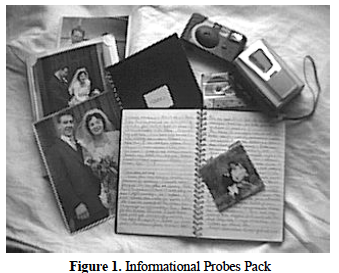Finnish academic Tuuli Mattelmäki (2006, p58) says that there are four powerful reasons for applying probes: INSPIRATION; INFORMATION; PARTICIPATION; and DIALOGUE.
All four of these reasons fit into my rationale for designing a probe for the initial recruitment phase of my research project. To be able to bracket my understanding of the phenomenon of aesthetics of use I have to be very careful how I prepare volunteers from the briefings. I cannot guide them in the use of an interactive installation, but I don't just want the volunteer to flounder in the face of unfamiliar technology.
 Source: (Mattelmäki, 2006)
Source: (Mattelmäki, 2006) Source: (Mattelmäki, 2006)
Source: (Mattelmäki, 2006) Source: (Mattelmäki, 2006)
Source: (Mattelmäki, 2006) Source: (Mattelmäki, 2006)
Source: (Mattelmäki, 2006)I want to prepare them enough to understand it, but it is THEIR experience of the technology I am interested in. To ensure they appreciate what I am there for is not the same as them, I need to enter into a controlled (phenomenonologically bracketed) DIALOGUE with them so they have an awareness about 'experience'. Through the first part of MY PROBE they will be INSPIRED to PARTICIPATE through some reflective INFORMATION from them. My thoughts are for this stage is to use the postcard component of a Cultural Probe.
This "Experience Pack" Probe Kit will be designed by myself and will be given out only to those who commit to volunteering at the briefings as homework before I meet them again for the first pre-observation contextual interview. The first task (more on this in a future post) will begin their awareness of what I am examining without me being didactic. At the contextual interview their responses can then be the focus of the discussion, through which I can prepare them for observation without influencing their potential actions on the day.
I will have a second post-observation task in the Probe they can do as an evaluatory and reflective exercise soon after their fun with the interactive installation. The results of this task will then be brought to the post-observation contextual interview. This means the design of only two components. As the abilities with technology are mixed within the potential volunteers I will include in the pack very concise directions for use, and maybe also a CD with oral directions too. This pack will be aesthetic too to facilitate engagement, and a souvenir of their time spent. Maybe also a certificate of involvement will be appealing to them? The Probe will fit in a tin meant to fit a plastic DVD box, and I'm thinking of applying a vinyl logo to the front of the case. This logo will be a numbered limited edition to add to the exclusiveness of those who volunteer out of those attending the briefing.
There are four stages to the Aesthetic Volunteers involvement: BRIEFING; INTERVIEW 1; OBSERVATION; and INTERVIEW 2. There are four reasons to apply a Probe (see above). The number FOUR seems to be a recurring number, so I will limit the Probe's contents to be FOUR items: TASK 1 (4 questions on 4 postcards); TASK 2 (TBA); 1 CD; and 1 CERTIFICATE.
But my "Experience Pack" isn't really a Cultural Probe as I'm more interested in finding out about experience from a phenomenological perspective. Does this make my pack a "Phenomena Probe"? Is it an "Empathy Probe"? Or is it a "Socio-cultural Probe"? I think I need to read Mattelmäki's PhD Dissertation to answer that.
References used:
BERNHAUPT, R., WEISS, A., OBRIST, M., and TSCHELIGI, M. (2007) Playful Probing: Making Probing More Fun. In Proceedings of the 11th IFIP TC 13 international Conference on Human-Computer interaction (Rio de Janeiro, Brazil). C. Baranauskas, P. Palanque, J. Abascal, and S. D. Barbosa, Eds. Lecture Notes In Computer Science. Springer-Verlag, Berlin, Heidelberg, 606-619.
CRABTREE, A., HEMMINGS, T., RODDEN, T., CHEVERST, K., CLARKE, K., DEWSBURY, G. AND ROUNCEFIELD, M. (2002) Probing for Information. In the proceedings of the 2nd EQUATOR Conference. November 2002. Brockenhurst. [Accessed 4 August 2010]. Available from World Wide Web: http://bscw.cs.ncl.ac.uk/pub/nj_bscw.cgi/S4ace2ee7/d50013/Crabtree,%20Hemmings,%20Rodden,%20Cheverst,%20Clarke,%20Dewsbury%20and%20Rouncefield-Probing%20for%20Information..pdf
DALSGAARD, T., SKOV, M.B., STOUGAARD, M. and THOMASSEN, B. (2006) Mediated Intimacy In Families: Understanding The Relation Between Children and Parents. In the proceedings of the 2006 Conference on Interaction Design and Children, June 07-09, 2006, Tampere, Finland. [Accessed 5 August 2010]. Available from World Wide Web: http://portal.acm.org/citation.cfm?id=1139110
JÚDICE, A. and JÚDICE, M. (2007) Designing Cultural Probes to Study “Invisible” Communities in Brazil. In the proceedings of Design Inquiries: The second Nordic Design Research Conference. Stockholm 27-30 May, Stockholm. [Accessed 5 August 2010]. Available from World Wide Web: http://www.nordes.org/data/uploads/papers/140.pdf
KJELDSKOV, J., GIBBS, M. R., VETERE, F., HOWARD, S., PEDELL, S., MECOLES, K. and BUNYAN, M. (2004) Using Cultural Probes to Explore Mediated Intimacy. In the proceedings of OzCHI, University of Wollongong, [Accessed 4 August 2010]. Available from World Wide Web: http://dl.acs.org.au/index.php/ajis/article/viewFile/128/107
MATTELMÄKI, T. (2006). Design Probes. Unpublished doctoral dissertation, University of Art and Design Helsinki. Helsinki, Finland.






No comments:
Post a Comment